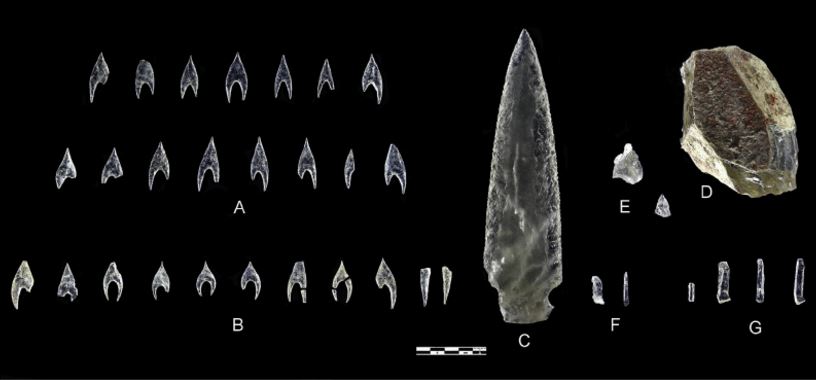Mankind’s fascination with crystals apparently dates back further than we can imagine. Experts in Spain, excavated a long dagger blade, twenty-five arrowheads, and a core, concluding that “great skill must have been required to produce these unique features when using rock crystal.”
An excavation of megalithic tombs in the locality in Valencina de la Concepción, southwest of Spain has yielded a ‘remarkable set’ of crystal weapons. The crystal weapons are described as exceptional and wonderfully well preserved.
It is estimated that the objects date from the year 3000 BC.
Excavating a “Great megalithic construction…Which extends over 43.75m in total” in Spain called the Montelirio tholos—constructed out of large slabs of slate—experts came across the grave of around 25 individuals within the structure.
Numerous items were found interred within the original structure, including: “an extraordinary set of sumptuous grave goods…the most notable of which is an unspecified number of shrouds or clothes made of tens of thousands of perforated beads and decorated with amber beads”.

But the most incredible part of the finding was a large number of crystal arrowheads and other objects made of crystals.
Experts discovered—and later presented in a study— numerous items including a long dagger blade, twenty-five arrowheads, and a core, all of which form the most technically sophisticated and aesthetically impressive collection of rock crystal material culture ever found.
In a second structure dubbed 10.042-10.049—also constructed from slate slabs—experts found a body of a young individual believed to have been between 17 and 25 years of age lying in a fetal position surrounded by a large set of grave goods. These included an undecorated elephant tusk laid above the young man’s head, a set of 23 flint blades, and numerous ivory objects.
As noted by experts: “The rock crystal dagger blade appeared in the upper level of Structure 10.049 of the PP4-Montelirio sector, in association with an ivory hilt and sheath, which renders it an exceptional object in Late Prehistoric Europe… The blade is 214 mm in length, a maximum of 59 mm in width and 13 mm thick. Its morphology is not unheard of in the Iberian Peninsula, although all the samples recorded thus far were made from flint and not rock crystal…”

Experts observed that the weapons are more or less the same shape as the flint arrowheads that were common within the area during this time, but crystal weapons would have required a much higher level of ability to create.
There aren’t any crystal mines in the vicinity suggesting that the builders of the objects must have traveled for many hundreds of miles in order to acquire the material for their weapons and tools.
The shortage of crystal suggests that these were weapons belonging to an elite group of people. However, experts say that the crystal weapons were found in a separated chamber and with their ‘owners’. Historians speculate that the crystal weapons were collectively owned by all of the individuals that were buried in the megalith.
As noted by experts in the study: The more technically sophisticated items, however, were deposited in the larger megalithic structures…As such, it is reasonable to assume that although the raw material was relatively available throughout the community…only the kin groups, factions or individuals who were buried in megaliths were able to afford the added value that allowed the production of sophisticated objects such as arrowheads or dagger blades.
Check out the entire study here.
Source: